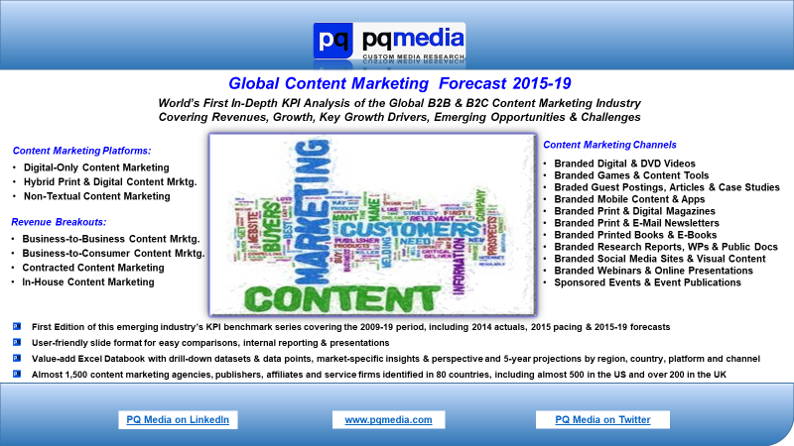Your cart is currently empty!
Research Reports
Global Content Marketing Forecast 2015
Description
If there was any doubt that content is king prior to 2015, that notion has long since faded and has been replaced by echoes of a refrain that resonated through the branded entertainment industry in recent years: “What’s old is new again.” But for the dynamic content marketing sector, there’s nothing old about a blazing streak of double-digit expansion since the throes of the Great Recession in 2009. And while its roots go back as far as product placement more than a century ago, content marketing has not only weathered the more recent tidal shifts causing disruptions across the communications ecosystem, it has risen to the fore as one of the most valuable digital & alternative media solutions.
Content may be king again, but content marketing is not new. It has evolved through a series of labels and definitions since the 19th century, including custom publishing, and today it shines as a segment of the ever-changing branded content sphere, which also includes branded entertainment, product placement, custom publishing, native advertising and advertainment, among others.
But like other forms of successful branded content, this platform is able to combine the use of both traditional and digital & alternative media channels by developing content specific to the needs of target consumers. As a result, content marketing is capable of creating emotional connections by engaging audiences through multiple channels with the power of effective storytelling.
Driven by a rapid phase of evolutionary shifts, a seminal transformation has pushed the global media ecosystem past the digital tipping point, hastening the fragmentation of the advertising and marketing sectors as brand marketers, ad agencies, content producers, and media investors scramble to redesign their strategic growth plans. The key to their success will be their ability to make smarter, faster business decisions during an era of frenetic shifts spanning the worlds of technology, media and telecommunications. These changes have created an abundance of choices for consumers and businesses regarding wireless devices, digital media, rich content, broadband access, and cloud computing.
As a result, consumers – particularly young Millennials – have become more mobile, elusive, multicultural, multitasking, and in control of their digital environments while demonstrating shorter attention spans. There are literally millions of content distribution channels operating today that were not available just a few decades ago, resulting in target audiences that are overloaded with ad messages and brand marketers overwhelmed with the clutter they must pierce in order to engage consumers at the right time and location.
With the explosion of more than 150 different ad and marketing channels as of mid-2015, brand messages can easily get lost if the intended consumer is media multitasking, or worse yet, viewing content on devices with ad-skipping tech, ensuring most commercials are missed entirely. Consequently, brands and agencies have had to reevaluate the media buying process in an age of multichannel and cross-channel integrated marketing solutions.
As it passed through various evolutionary stages, content marketing has built credibility as an effective component of integrated media campaigns because brands have found it to be successful at breaking through the increasing clutter distracting potential end users. And with the various differences between B2C and B2B markets, the content you publish today is more important than ever. It must be driven by well-planned strategic marketing campaigns that feature targeted content and leverage the strengths of traditional and digital media.
To help you navigate this dynamic media platform, PQ Media deployed its top research analysts into the field and pored over decades of proprietary global market intelligence to develop the first-ever econometric analysis of the size, growth, segmentation, key growth drivers, and the challenges ahead for the growing B2B and B2C content marketing industry. PQ analysts have identified which global markets are the largest and the fastest growing; which hold the most potential; which media channels offer the most opportunities and challenges; which countries rank among the Top 15 Global Markets, and many other important analytics, including the following key data points:
- Value of global content marketing worldwide grew 13% in 2014 to $26.5 billion, and PQ analysts project it will accelerate at a 15% CAGR in the 2014-19 period to over $50 billion;
- B2B content accounted for 53% of the global market value in 2014, while B2C content grew at a faster 14% rate for the year;
- USA is the world’s largest overall content market, generating $12 billion in 2014, although it ranked 12th in annual growth, more than 10 points behind top-ranked South Korea, which rocketed 26%;
- Branded print & digital magazines is the largest content marketing channel at $8 billion, while branded mobile content & apps grew the fastest in 2014, soaring 62%;
PQ Media executives have been instrumental in defining, segmenting and sizing the content marketing industry from the beginning, nearly 20 years ago. As such, we’ve worked exhaustively over the past year to ensure we deliver to you the most comprehensive, in-depth, credible and actionable strategic intelligence ever published on the global content marketing industry, spanning the four major regions, 15 leading markets, three key sectors, and 13 media channels. And we’ve packaged all this content into the most data-rich product bundle ever assembled on this industry, including:
- 324-slide PowerPoint deck designed as the core report;
- Accentuated with a new, deep-dive, supplemental Excel databook, featuring nearly 40,000 data points and providing details on more than 1,000 content marketing companies operating worldwide;
- Package covers the 2009-19 period, including 2014 actuals, 2015 pacings, and 2015-19 forecasts
